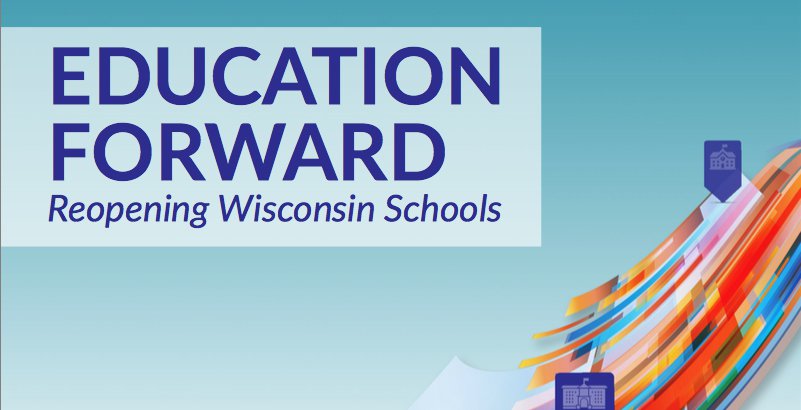WISCONSIN - The much-anticipated school reopening guidance from the Wisconsin Department of Public Instruction arrived at 7 a.m. Monday, June 22.
The 83-page booklet of guidance is titled ‘Education Forward-Safely and Successfully Reopening Wisconsin Schools.’ Locally, school administrators, health officials and host of other interested parties were busy reading the DPI’s advice on Monday.
In the publication’s foreword, the Wisconsin State Superintendent of Public Instruction Carolyn Stanford Taylor addressed the situation facing schools that will be reopening this fall in the midst of the COVID-19 pandemic.
“Responding to COVID-19 is a tremendous undertaking for schools,” Stanford Taylor wrote. “Schools are tasked with re-envisioning educational delivery models in a span of weeks and adjusting practices accordingly. As we look toward the fall, the safety and health of our students, educators, and families remains of the highest importance. The Department of Public Instruction (DPI) is providing this guidance to aid in school districts’ decision making as they look to build educational services and supports in a COVID-19 environment.”
A key that was readily apparent in reading ‘Education Forward’ was that it was meant as guidance from the DPI for the state’s school districts. ‘Education Forward’ does not contain rules, regulations or orders for the districts to follow. Instead it provides suggestions, options, alternatives and advice for the districts to consider as they create their own unique plans on how to successfully reopen schools this fall.
“There are 421 school districts, 26 independent charter schools, and 792 private schools serving a school-age population of over 1,000,000 students in Wisconsin,” Stanford Taylor wrote in her foreword. “Due to the extensive variance in schools, this guidance is offered as a workbook to be considered in conjunction with the Department of Health Services risk assessment checklist. Please use these tools to discuss school district reopening plans with local health agencies and ensure information is complete in regards to the magnitude of risk associated with options being considered.”
Seneca School District Administrator Dave Boland explained the committee working on the school reopening would work through the guidance and see how it impacts the local district.
“We need to come up with an idea of how what they said, affects us,” Boland explained.
Boland also noted that the guidance will change as the situation changes.
“We will need multiple plans as the virus changes,” the administrator said.
The North Crawford School District also has a committee working on a reopening plan, but has been anxiously waiting for the DPI guidance.
“We have started doing some planning and okay we think we want to do this, but we’re waiting to see what DPI says first,” Munson said.
Now, it’s time for the district to see how this initial tentative planning matches the guidance being given by DPI.
One thing that caught the attention of both administrators was the DPI’s suggestion that districts try to have a student-to-teacher ratio of 10-to-1 to help with social distancing.
“That would be a big deal for us,” Munson said. “So, this is not a rule or an order. It’s all recommendations. All decisions are local decisions and they provide room for different situations. In the end, the districts will do what they think is best for their situation.”
Munson said while the elementary school is close to accommodating the 10-to-1 ration, the middle school and high school are not.
“For instance, it’s just not practical for us to offer four freshman English classes,” Munson said.
Boland also questioned the practicality of a 10-to-1 ratio for Seneca. He explained that if the district maintained that kind of ratio there just would not be enough personnel to operate the classes.
“It’s just real preliminary now,” Boland said. “They’re just throwing out options for you to consider. This is just guidance. Everything we’re getting says that now. No one wants to stick their neck out.”
Munson was also struck by the total lack of specific standards or levels that districts should meet.
Both administrators acknowledged that virtual learning from home or sites outside of the building will be part of any reopening plan.
Munson emphasized that the virtual education offered by the district will be much more developed than what was constructed last spring on a few days’ notice after the Safer at Home order was issued.
“I have stressed to people that what we did was more aptly called emergency remote education not virtual learning,” Munson said. “Now we have a lot more time to plan. We’ve been planning since March. We’ll have six months of planning going into the fall.”
North Crawford surveyed families and has found 15 families who want only virtual education for their children-that’s about 30 students. The district believes they can accommodate such a request.
There’s a lot of guidance in ‘Education Forward.’ The DPI divides learning options into three categories: In-Person Learning, Physically Distanced Learning and Virtual Learning.
The different kinds of learning are then presented in host of attendance combinations including four-day weeks. Two-day rotations, every-other-day attendance and much more. The goal is to reduce crowding, which allows for more social distancing, while still delivering the academic material to the students.
All of the Crawford County school districts took part in a virtual meeting with county public health officer Cindy Riniker. She expects another meeting will be held soon, since the DPI guidance has been issued.
Riniker did note that as of last week she was told by the deputy administrator of the Wisconsin Department of Health Services that there would be no mass COVID-19 testing of returning K-12 students this fall. The reason given was the state doesn’t have the capacity or the funds to conduct such testing.




